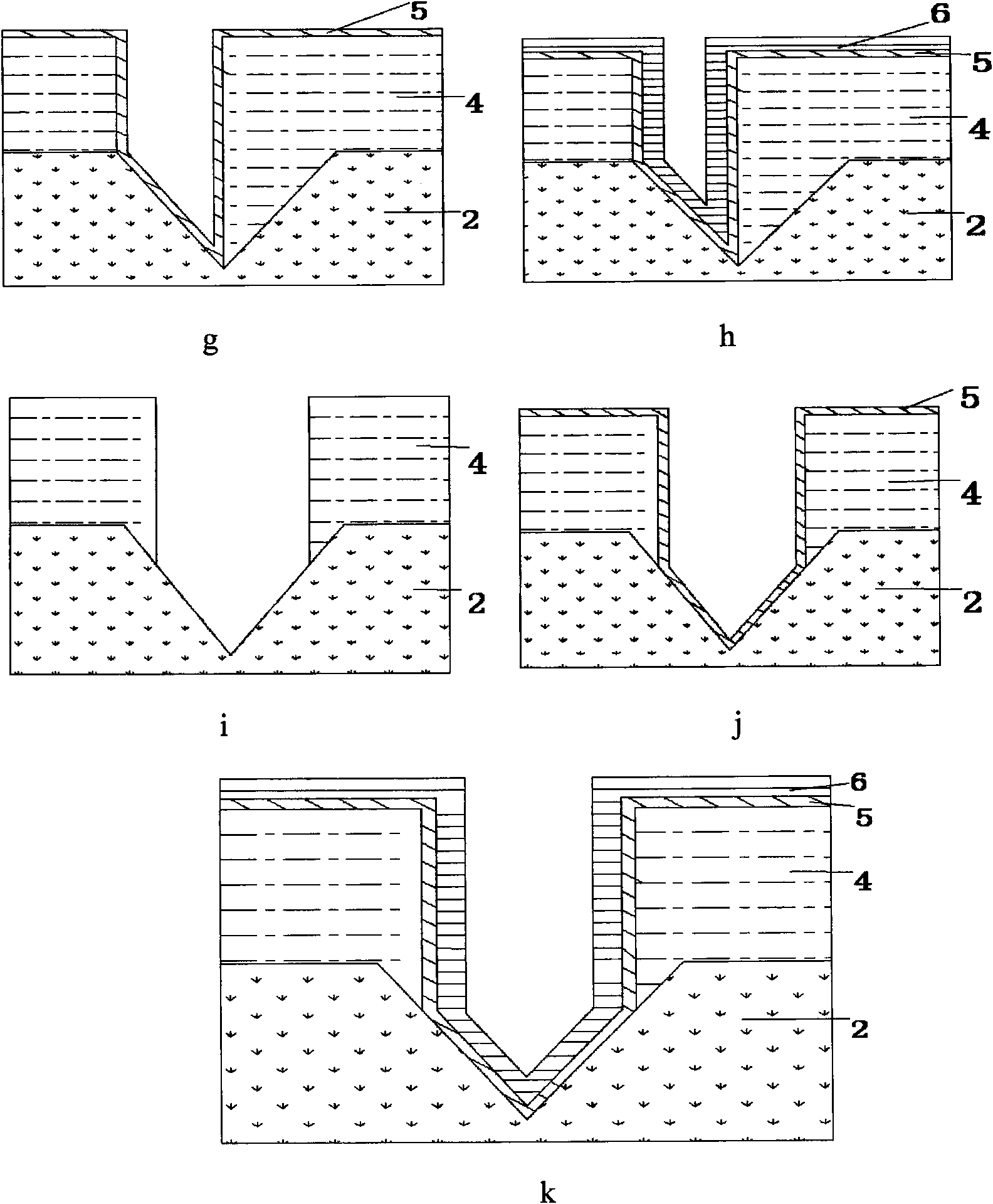Preparation method of hollow medical metal micro-needle
A micro-needle and metal technology, applied in the directions of micro-needles, needles, and drug devices, can solve the problems of easy breakage, high cost, and the needle tip is not sharp, and achieve the effect of good mechanical properties, low processing cost, and improved effect.
- Summary
- Abstract
- Description
- Claims
- Application Information
AI Technical Summary
Problems solved by technology
Method used
Image
Examples
Embodiment 1
[0033] Such as figure 1 a and figure 2 As shown, in this embodiment, a right-angled triangular mask is used to form oblique triangular truss microneedles when removing the negative glue that fills the silicon pit.
[0034] 1. Bake the double-polished silicon oxide wafer in an oven at 180°C for 3 hours, then spin-coat a photoresist positive resist of 5 μm on the front side of the double-polished silicon oxide wafer, and then bake at 95°C for 30 minutes. figure 1 As shown in a, wherein: the silicon dioxide layer 1 is located on both sides of the silicon 2, and its thickness is 2-3 μm;
[0035] 2. Use the mask plate with the target pattern to expose, and open a square photoresist positive window with a side length of 350 μm after development, such as figure 1 As shown in b, 3 is the photoresist positive resist layer;
[0036] 3. Bake at 90°C for 30 minutes, and then throw a layer of photoresist positive resist on the back of the double-polished silicon oxide wafer, with a thi...
Embodiment 2
[0053] Such as figure 1 b and figure 2 As shown, in this embodiment, an oblique triangular mask is used to form a right-angled triangular truss microneedle when removing the negative resist that fills the silicon pit.
[0054] 1. Bake the double-polished silicon oxide wafer in an oven at 180°C for 3 hours, then spin-coat a photoresist positive resist of 5 μm on the front side of the double-polished silicon oxide wafer, and then bake at 95°C for 30 minutes. figure 2 As shown in a, wherein: silicon dioxide layer 1 is located on both sides of silicon 2, and its thickness is 2.5 μm;
[0055] 2. Use the mask plate with the target pattern to expose, and open a square photoresist positive window with a side length of 350 μm after development, such as figure 2 As shown in b, 3 is the photoresist positive resist layer;
[0056] 3. Bake at 90°C for 30 minutes, and then throw a layer of photoresist positive resist on the back of the double-polished silicon oxide wafer, with a thick...
Embodiment 3
[0073] Such as figure 1 c and figure 2 As shown, in this embodiment, a square mask is used to form a square-shaped microneedle when removing the negative glue that fills the silicon pit. The specific steps are as follows:
[0074] 1. Bake the double-polished silicon oxide wafer in an oven at 180°C for 3 hours, then spin-coat a photoresist positive resist of 5 μm on the front side of the double-polished silicon oxide wafer, and then bake at 95°C for 30 minutes. figure 1 As shown in a, wherein: the silicon dioxide layer 1 is located on both sides of the silicon 2, and its thickness is 2-3 μm;
[0075] 2. Expose with a mask plate with the target pattern ready, and open a square photoresist window with a side length of 350 μm after development, such as figure 1 As shown in b, 3 is the photoresist positive resist layer;
[0076] 3. Bake at 90°C for 30 minutes, and then throw a layer of photoresist positive resist on the back of the double-polished silicon oxide wafer, with a th...
PUM
| Property | Measurement | Unit |
|---|---|---|
| Depth | aaaaa | aaaaa |
| Thickness | aaaaa | aaaaa |
| Depth | aaaaa | aaaaa |
Abstract
Description
Claims
Application Information
 Login to View More
Login to View More - R&D
- Intellectual Property
- Life Sciences
- Materials
- Tech Scout
- Unparalleled Data Quality
- Higher Quality Content
- 60% Fewer Hallucinations
Browse by: Latest US Patents, China's latest patents, Technical Efficacy Thesaurus, Application Domain, Technology Topic, Popular Technical Reports.
© 2025 PatSnap. All rights reserved.Legal|Privacy policy|Modern Slavery Act Transparency Statement|Sitemap|About US| Contact US: help@patsnap.com



